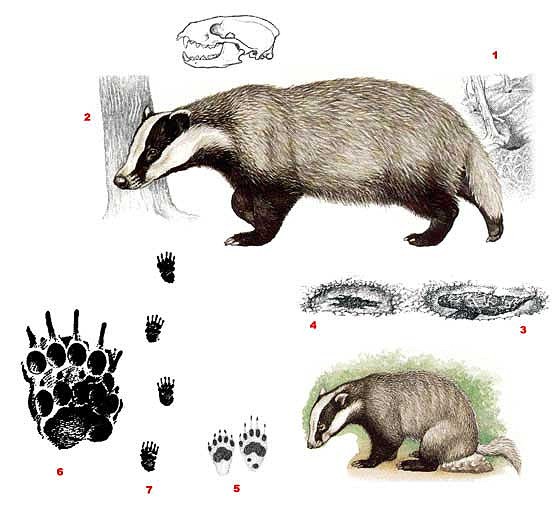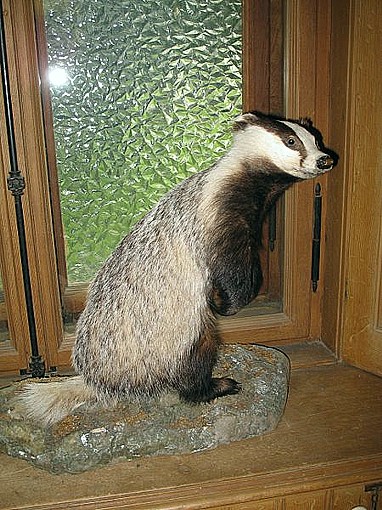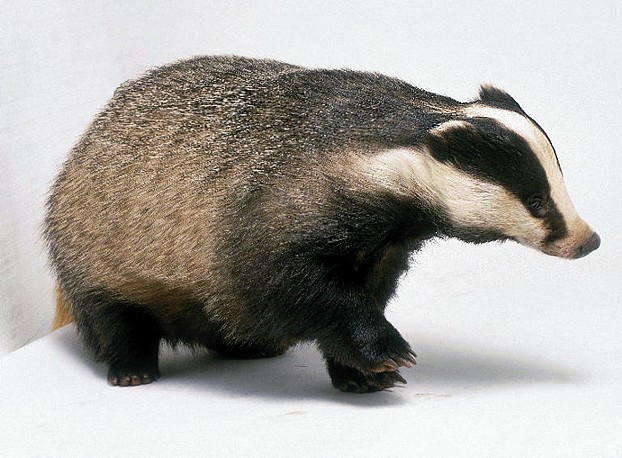Lessico
Tasso
eurasiatico
Meles meles

In latino classico il tasso era detto meles/maeles/melis, genitivo
melis, sostantivo di genere femminile. Tasso deriva dal latino tardo taxus
oppure taxo -onis, attestato nel sec. V dC (Marcello Empirico![]() verso la stessa epoca usa il derivato taxoninus: adeps taxonina
‘grasso di tasso’), di probabile origine germanica. Confronta il tedesco Dachs.
verso la stessa epoca usa il derivato taxoninus: adeps taxonina
‘grasso di tasso’), di probabile origine germanica. Confronta il tedesco Dachs.
Tasso è il nome comune di Carnivori Mustelidi caratterizzati da
corporatura tarchiata simile a quella di un cane bassotto![]() , arti brevi e robusti, coda corta . Diffusa in Italia (tranne nelle
isole) è la specie euroasiatica Meles meles o tasso comune, lungo 65
cm ca., con coda di 15-20 cm, altezza 30 cm e peso sino a 17-20 kg. Ha testa
appiattita, occhi piccoli a pupilla rotonda, pelliccia ruvida e non folta, con
peli assai più lunghi sui fianchi. Il manto è superiormente nero brizzolato,
più chiaro sui fianchi, nerastro nelle parti inferiori. La testa, biancastra,
porta di lato due larghe bande nerastre, che si estendono sino ai lati del
collo.
, arti brevi e robusti, coda corta . Diffusa in Italia (tranne nelle
isole) è la specie euroasiatica Meles meles o tasso comune, lungo 65
cm ca., con coda di 15-20 cm, altezza 30 cm e peso sino a 17-20 kg. Ha testa
appiattita, occhi piccoli a pupilla rotonda, pelliccia ruvida e non folta, con
peli assai più lunghi sui fianchi. Il manto è superiormente nero brizzolato,
più chiaro sui fianchi, nerastro nelle parti inferiori. La testa, biancastra,
porta di lato due larghe bande nerastre, che si estendono sino ai lati del
collo.
Onnivoro, si ciba degli animali più vari (compresa la vipera, al cui veleno risulta immune) nonché di uova e di una ricca quantità di vegetali. Si nutre inoltre di miele, di larve di vespe e di api selvatiche, e si difende dalle punture di questi insetti grazie al pelo ispido.Vive nei boschi, lungo le valli e non lontano dai coltivi; è notturno. Scava una tana provvista di una o più gallerie di accesso. Talvolta condivide la tana con la volpe. In questo caso i due animali usano ingressi e gallerie diverse.
Il suo sonno invernale non è un vero letargo. La gestazione dura 7-8 mesi e alla luce vengono 4-5 piccoli per ogni parto inizialmente privi di pelo e ciechi. La pelliccia di tasso, praticamente indistruttibile, ha pelo fitto e lungo, di colore grigio. Viene usata soprattutto per guarnizioni; i peli più lunghi per la fabbricazione di spazzole e pennelli da barba.

Tasso conservato presso il museo di Gressoney Saint Jean (AO)

The
Eurasian or European badger, Meles meles, is a mammal indigenous to
most of Europe (excluding northern Scandinavia, Iceland, Corsica, Sardinia,
Sicily and Cyprus) and to many parts of Asia, from about 15° to 65° North,
and from about 10° West to 135° East. It is particularly abundant in Britain
and Ireland.
It is a member of the Mustelidae family, and so is related to the
stoats, otters, weasels, minks and other badgers. The Eurasian badger is the
only species classified in the genus Meles. Accepted subspecies include
Meles meles meles (Western Europe), Meles meles marianensis (Spain
and Portugal), Meles meles leptorynchus (Russia), Meles meles
leucurus (China and Tibet), and Meles meles anaguma (Japan).
The general hue of its fur is grey above and black on the under parts with a distinctive black and white striped face and white-tipped ears. Eurasian badgers are around 70 cm long with a tail of about 20 cm and weigh 10 kg on average, but weights can vary enormously. In the northern area of the range (only), badgers hibernate and put on fat in the autumn to help them get through the winter months. In parts of Russia, badgers may weigh as much as 32 kg in the autumn.
Though classified as belonging to the order Carnivora, badgers are effectively omnivorous; most of their diet consists of earthworms, although they also eat insects, beetles, small mammals, reptiles, amphibians, eggs, young birds, berries, roots, bulbs, nuts, fruit, and other plant matter, depending on the season. They also dig up the nests of wasps and bumblebees in order to eat the larvae.
Badgers prefer grazed pasture and woodland, which have high numbers of earthworms exposed, and dislike clay soil, which is difficult to dig even with their powerful claws. In urban areas, some badgers scavenge food from bins and gardens.
Badgers are nocturnal and spend the day in their setts, or extensive networks of tunnels dug in well-drained ground (or sometimes beneath buildings or roads). Setts give shelter from the weather and predators, including humans and dogs.
They are territorial, but can be found in groups (called clans) of up to 12. Each clan has a dominant male and female which are often (but not always) the only members of the clan to reproduce. Female badgers can display delayed implantation: after mating at any time of the year, they keep the fertilised eggs in suspended development until an appropriate time, at which stage the eggs are implanted and begin developing. Badgers have a gestation period of 7-8 weeks and give birth to 1-5 offspring. Males are called boars and females sows; the young are cubs. Badgers live for up to 15 years (average 3 years) in the wild, and up to 19 years in captivity. If they survive their first year, the most common cause of death is by road traffic.
Badgers are susceptible to Baylisascaris infestations. They can catch and carry rabies and are believed to transmit bovine tuberculosis (see below).
Badger
baiting, in which a badger is attacked by a succession of dogs, often
accompanied by heavy gambling, has been practiced since at least the Middle
Ages in Europe. When the badger is no longer able to fight, it is killed.
Badger digging is the process of sending dogs down the tunnels of a badger
sett in order to locate the badger, after which the diggers try to dig down to
the badger. Dachshunds![]() (literally
"Dachs hunds", "badger dogs") were originally bred for
this purpose.
(literally
"Dachs hunds", "badger dogs") were originally bred for
this purpose.
In the UK, the Badger Trust believes that lamping (night-time hunting on foot with strong lamps) for badgers, badger baiting and badger digging persist despite all being illegal. Badger baiting was outlawed in 1835; badger digging in 1973. Lamping with dogs is legal only if rabbits are hunted since the passing of the Hunting Act 2004, lamping with guns is legal only for species not protected under the Wildlife and Countryside Act 1981. Under the Protection of Badgers Act of 1992 it is an offence to kill a badger or to interfere with a sett without a licence from Natural England.
The results of the first national badger survey published in 1990 estimated that 9,000 badgers were killed each year by badger digging.
Badgers and the spread of bovine TB
British farmers and successive governments have long believed that bovine TB was being spread by badgers and infecting the national dairy herd, and since the 1970s badgers have been culled by gassing (now ceased) and shooting in attempts to prevent this spread.
Tests carried out by the Ministry of Agriculture in the early 1970s showed that TB was more common in badgers than in other species. In the first Badger Act (1973), meant that licenses had to be issued for the killing of badgers. However there are various other theories concerning the transmission of TB to cattle, and badger culling remains a contentious issue in the UK. Research into the specific mechanisms of how cattle contract bovine TB from badgers and into normal levels of transmission when culling is not practised is scanty. Following the recommendations of the Krebs report of 1997 (Bovine Tuberculosis in Cattle and Badgers), a research trial of badger culling, the Randomised Badger Culling Trial (RBCT), was begun. Part of the aim was to establish baselines which could be used to assess the efficacy of culls in future. As noted in the Godfray report (Independent Scientific Review of the Randomised Badger Culling Trial and Associated Epidemiological Research) of March 2004, the trial has experienced major problems (in particular delays in culling due to restrictions imposed by the control of the foot and mouth disease epidemic in 2001.
The Randomised Badger Culling Trial (designed, overseen and analysed by the Independent Scientific Group on Cattle TB, or ISG) was a large field trial of widescale (proactive) culling and localised reactive culling (in comparison with areas which received no badger culling). In their final report, the ISG concluded: "First, while badgers are clearly a source of cattle TB, careful evaluation of our own and others’ data indicates that badger culling can make no meaningful contribution to cattle TB control in Britain. Indeed, some policies under consideration are likely to make matters worse rather than better. Second, weaknesses in cattle testing regimes mean that cattle themselves contribute significantly to the persistence and spread of disease in all areas where TB occurs, and in some parts of Britain are likely to be the main source of infection. Scientific findings indicate that the rising incidence of disease can be reversed, and geographical spread contained, by the rigid application of cattle-based control measures alone." On 26 July 2007, the Minister of State, Department for Environment, Food and Rural Affairs (Lord Rooker) said "My Lords, we welcome the Independent Scientific Group’s final report, which further improves the evidence base. We are carefully considering the issues that the report raises, and will continue to work with industry, government advisers and scientific experts in reaching policy decisions on these issues."
Badgers are popular with the general public, if not with farmers, and societies exist to protect the species. The Badger Trust is the umbrella body for a series of groups like the Lancashire Badger Group formed for the conservation of these animals. Their most serious threat is automobile traffic, which kills about 50,000 badgers a year in Britain. In 2004, there were between 250,000 and 300,000 badgers in the wild in Britain.